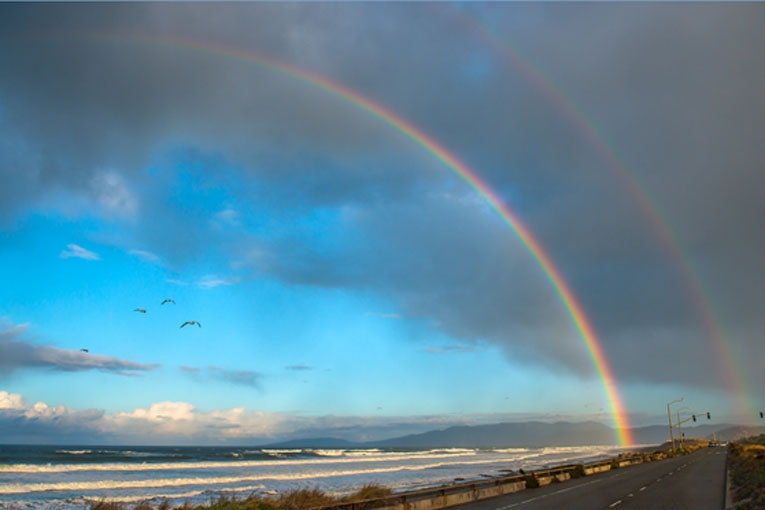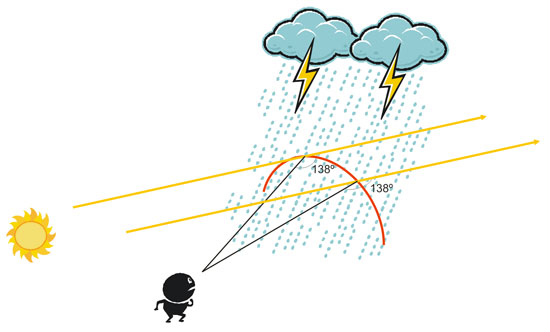
Question sent by GUILLERMO GUEVARA PARDO (Bogota). FERNANDO BALLESTEROS answers:
Although raindrops are usually represented in the shape of a teardrop, actually, they are almost circular. When a beam of light enters a raindrop, its light separates into colours (as it happens when light goes through glass, for instance) and changes its direction. When this light gets to the other side of the droplet and tries to get out of it, a small fraction of it does not reach the other side and it is reflected backwards, almost coming out of the raindrop from where it had previously entered. That is, raindrops reflect backwards a small percentage of the light that comes through them, separating it into colours. But saying backwards is not exactly accurate. Since raindrops are curved, when light is reflected and refracted once and again in this curvy area, light is reflected at an angle of 138º with respect to incidental light. This is the angle that explains the rainbow.
Suppose the following situation. The Sun is behind us, near the horizon, and, in the distance, in front of us it is raining, and the Sun throws its light on these drops. All of them are reflecting backwards part of this sunlight, separated into colours. However, we will not be able to perceive this light coming from every raindrop, only from some of them, from those that, regarding my position, make exactly an angle of 138º with respect to sunlight, for only in this case will the reflected light reach our eyes.

Every point in a curtain of rain that, regarding my position, make an angle of 138º with respect to the sunlight make up a hoop or a ring. Therefore, we should actually call it Rainhoop, but the lower part of this hoop disappears in the ground (where there are no raindrops): that is why we see a bow. Sometimes, it is possible to see the whole hoop. For instance, if we are at the edge of a waterfall and the Sun is behind us and the foam the waterfall produces is in front of us. We can also make it happen: if we take a garden hose with a mouthpiece that mists water, and we start it up in front of us with the Sun behind us, we will see the whole hoop.
Of course, when we move to one side, the light will not come from the same drops, but from the ones next to them. That is, in each position we see a different rainbow. Two people watching together a rainbow would not be seeing the exact same rainbow; the raindrops that send the sunlight back to our eyes separated into colours would not be the same ones for each of them. This becomes more obvious when the raindrops are closer to us, which is the case of the hose; or if we move quickly, just like when we watch the rainbow from a car in motion.
We will often see that the rainbow is not simple, but double (or triple). This happens because the light inside the raindrop is reflected more times before coming out of it (although the more reflections there are, the weaker they become, and those secondary rainbows are fainter, while the third ones become almost imperceptible). The second rainbow goes backwards making an angle of 130º with incidental sunlight, which makes it look bigger. Finally, if the sun is too high on the horizon (above 40º), the rainbow will appear under the horizon, and consequently we will not be able see it.
Fernando Ballesteros. Investigator of the Observatori Astronòmic de la Universitat de València.





